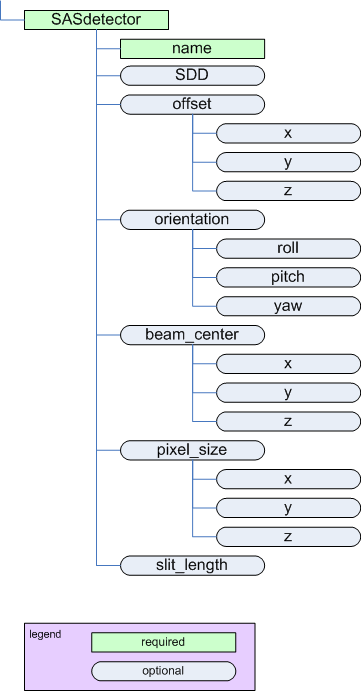Table Of Contents
Previous topic
Next topic
This Page
Quick search
Enter search terms or a module, class or function name.

The SASdetector element
| Name | Type | Occurrence | Description | Attributes |
|---|---|---|---|---|
| name | string | [1..1] | Identifies the name of this detector. | |
| SDD | float | [0..1] | Distance between sample and detector. | unit={unit} [1] |
| offset | container | [0..1] | Offset of this detector position in X, Y, (and Z if necessary). | |
| orientation | container | [0..1] | Orientation (rotation) of this detector in roll, pitch, and yaw. | |
| beam_center | container | [0..1] | Center of the beam on the detector in X, Y, (and Z if necessary). | |
| pixel_size | container | [0..1] | Size of detector pixels in X, Y, (and Z if necessary). | |
| slit_length | float | [0..1] | Slit length of the instrument for this detector, expressed in the same units as \(Q\). (See Rules) | unit={unit} [1] |
See the figures in Definition of the coordinate axes.
| Name | Type | Occurrence | Description | Attributes |
|---|---|---|---|---|
| \(x\) | float | [0..1] | Offset of the detector position in X. | unit={unit} [1] |
| \(y\) | float | [0..1] | Offset of the detector position in Y. | unit={unit} [1] |
| \(z\) | float | [0..1] | Offset of the detector position in Z. | unit={unit} [1] [2] |
Note
The orientation element is intended to describe simple rotations about a single axis rather than a full set of rotations as in a crystallographic context.
| Name | Type | Occurrence | Description | Attributes |
|---|---|---|---|---|
| roll | float | [0..1] | Rotation about the Z axis (roll). | unit={unit} [1] |
| pitch | float | [0..1] | Rotation about the X axis (pitch). | unit={unit} [1] |
| yaw | float | [0..1] | Rotation about the Y axis (yaw). | unit={unit} [1] |
Position of the beam center on the detector
| Name | Type | Occurrence | Description | Attributes |
|---|---|---|---|---|
| \(x\) | float | [0..1] | Position of the beam center on the detector in X. | unit={unit} [1] |
| \(y\) | float | [0..1] | Position of the beam center on the detector in Y. | unit={unit} [1] |
| \(z\) | float | [0..1] | Position of the beam center on the detector in Z. | unit={unit} [1] [2] |
| Name | Type | Occurrence | Description | Attributes |
|---|---|---|---|---|
| \(x\) | float | [0..1] | Size of a detector pixel in X. | unit={unit} [1] |
| \(y\) | float | [0..1] | Size of a detector pixel in Y. | unit={unit} [1] |
| \(z\) | float | [0..1] | Size of a detector pixel in Z. | unit={unit} [1] [2] |
Table Notes
| [1] | (1, 2, 3, 4, 5, 6, 7, 8, 9, 10, 11, 12, 13, 14) The unit attribute is required. See Rules for acceptable values. |
| [2] | (1, 2, 3) While \(z\) is allowed by the standard (provided by use of a standard size element in the XML Schema), it does not make sense to use it for small-angle scattering in some situations as noted. Use of \(z\) in such situations may be ignored by processing software. |